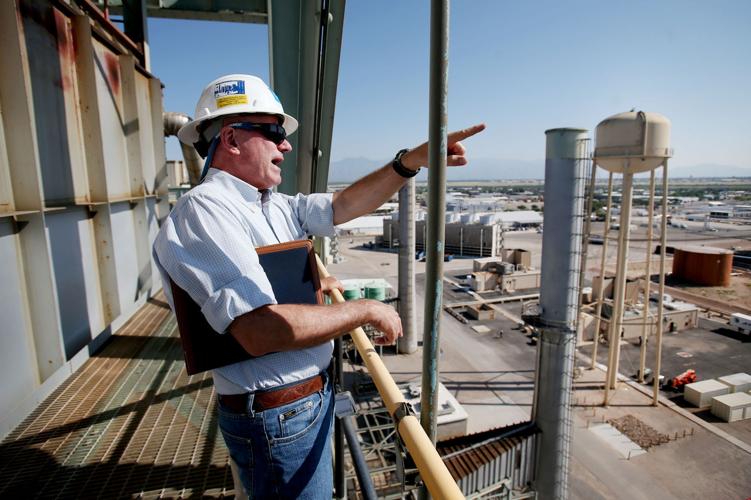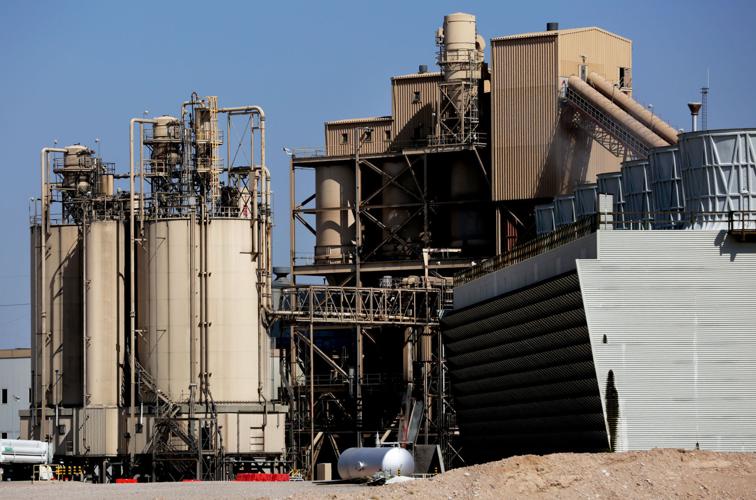Tucson Electric Power Co. is turning to an age-old technology to back up new renewable-energy resources.
A hint: It’s essentially the same technology you use every time you drive your car.
The company plans to build a new power plant using giant reciprocating natural-gas engines — similar to internal-combustion engines that have been around since the 1800s — on the grounds of its mainly gas-fired H. Wilson Sundt Generating Station on East Irvington Road.
“This is called ‘back to the future’ because this is a reciprocating engine, its the engine out of your car — but its a V-18 with 24-inch pistons,” said Conrad Spencer, director of the Sundt generation-modernization project for TEP.
In July, TEP issued a request for proposals to build the eventual 200-megawatt gas-engine power plant, which is expected to cost north of $200 million and be one of the largest of its kind in the U.S.
TEP and other utilities are looking to use the fast-starting gas engines as a flexible resource to handle peak power loads, especially to supplant power from renewable solar and wind resources, whose production drops off when clouds move over or the wind stops blowing.
Nearly 11 percent of the power delivered last year to TEP’s retail customers came from renewable resources, and TEP is working toward boosting that to at least 30 percent by 2030, doubling the state’s 2025 goal.
“When you introduce photovoltaics and wind, and they come and go with the wind and the clouds, you’ve got have something that will respond quicker,” Spencer said.
TEP also recently added 20MW of battery storage at two local sites, partly to provide fast, on-demand power to manage intermittent renewable resources.
Sundt’s four large gas-fired steam generators can take up to four hours to start up, and its two gas turbines — similar to jet engines — take about 10 minutes to start.
Ten minutes sounds fast, but every second counts as system operators constantly monitor and control the system to balance generation with demand, Spencer said.
“Every second, we’re looking at generation and consumption,” he said.
The latest generation of utility-sized reciprocating natural-gas engines takes just a few minutes to start and reach full output, and they are much more fuel-efficient than gas turbines, Spencer said.
“This can be stone-cold, and the guys in production, in five minutes they can have 20 megawatts, and an hour later, they don’t need it any more they shut it off,” he said.
Aside from backing up renewable-energy sources, industry experts say the move to reciprocating gas engines is being driven by performance improvements in engine design and historically low natural-gas prices, which also are driving the adoption of other gas technologies like combustion turbines.
At Sundt, TEP’s plan is to replace two of the plant’s steam generators, Units 1 and 2, which burn gas to produce steam that spins an electrical generator, with two sets of five, 20-megawatt reciprocating gas engines, improving the plant’s overall efficiency.
Replacing the two steam generators with the reciprocating engines will reduce Tucson-area emissions of nitrogen oxides, which contribute to ground-level ozone, by about 60 or about 350 tons per year, Spencer said, adding the unit use minimal water for cooling.
Besides supplying on-demand power, one of the gas engines will run nonstop to meet requirements that utilities constantly generate some minimum amount of power, Spencer said, more economically replacing Sundt’s Unit 4 generator for that duty.
When the steam generators are retired and the gas engines added, Sundt will have a slightly larger generating capacity than the 422MW currently available from the four steam generators.
TEP plans to build the reciprocating-engine power plant in two phases, bringing half of the units online by mid-2019 and the remaining units into service by mid-2021.
Final bids are due Oct. 2, and the successful bidder will be announced in November, TEP says.
The reciprocating engines will add to Sundt’s legacy of hosting multiple generating technologies.
Built in 1958 and formerly know as the Irvington Generating Station, the Sundt plant has seen its generating resources change with the times — and in some cases with the geopolitical climate.
The plant was originally built with four generating units that could burn diesel oil or natural gas.
In 1987, the plant’s Unit 4 generator was converted to additionally burn pulverized coal to comply with a 1978 act of Congress aimed at reducing America’s reliance on foreign oil.
In 1999, TEP began piping landfill methane gas from the Los Reales Landfill to Sundt’s Unit 4, and in 2014, TEP began using a solar thermal system to preheat water for the plant’s boilers, boosting the plant’s output buy 5MW during peak periods without increasing emissions.
In August 2015, in response to regulatory and cost concerns and amid pressure from environmental groups, TEP stopped burning coal two years ahead of its initial schedule.
The new gas-engine plant is planned for an area south of the main Sundt plant — perhaps ironically on a site that formerly contained a mountain of coal that supplied Unit 4 but is now scraped clean.
A local environmentalist who fought TEP’s use of coal at Sundt said he’s happy coal is gone there, but pointed out that though natural gas burns cleaner than coal, it’s still a polluting technology.
“Replacing one fossil fuel with another is not a solution,” said Dan Mills, the Tucson-based program coordinator for the Grand Canyon Chapter of the Sierra Club. “What we need to do is go 100 percent renewables, or as close to that as they can get.”
While TEP plans to move to 30 percent renewable energy by 2032, it also plans to boost its natural-gas generation from about 11 percent this year to 26 percent.







